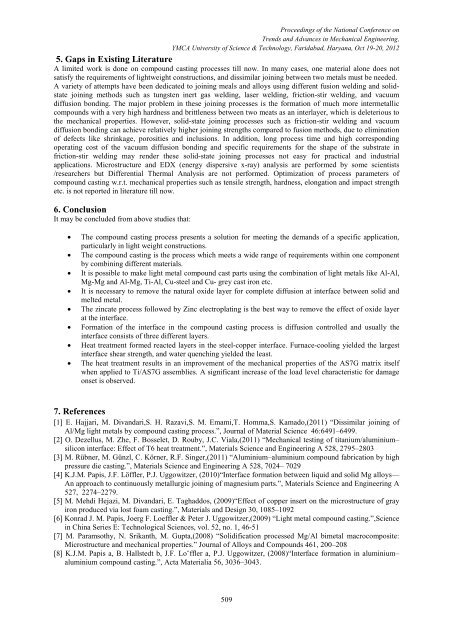compound casting - a literature review - YMCA University of Science ...
compound casting - a literature review - YMCA University of Science ...
compound casting - a literature review - YMCA University of Science ...
Create successful ePaper yourself
Turn your PDF publications into a flip-book with our unique Google optimized e-Paper software.
Proceedings <strong>of</strong> the National Conference onTrends and Advances in Mechanical Engineering,<strong>YMCA</strong> <strong>University</strong> <strong>of</strong> <strong>Science</strong> & Technology, Faridabad, Haryana, Oct 19-20, 20125. Gaps in Existing LiteratureA limited work is done on <strong>compound</strong> <strong>casting</strong> processes till now. In many cases, one material alone does notsatisfy the requirements <strong>of</strong> lightweight constructions, and dissimilar joining between two metals must be needed.A variety <strong>of</strong> attempts have been dedicated to joining meals and alloys using different fusion welding and solidstatejoining methods such as tungsten inert gas welding, laser welding, friction-stir welding, and vacuumdiffusion bonding. The major problem in these joining processes is the formation <strong>of</strong> much more intermetallic<strong>compound</strong>s with a very high hardness and brittleness between two meats as an interlayer, which is deleterious tothe mechanical properties. However, solid-state joining processes such as friction-stir welding and vacuumdiffusion bonding can achieve relatively higher joining strengths compared to fusion methods, due to elimination<strong>of</strong> defects like shrinkage, porosities and inclusions. In addition, long process time and high correspondingoperating cost <strong>of</strong> the vacuum diffusion bonding and specific requirements for the shape <strong>of</strong> the substrate infriction-stir welding may render these solid-state joining processes not easy for practical and industrialapplications. Microstructure and EDX (energy dispersive x-ray) analysis are performed by some scientists/researchers but Differential Thermal Analysis are not performed. Optimization <strong>of</strong> process parameters <strong>of</strong><strong>compound</strong> <strong>casting</strong> w.r.t. mechanical properties such as tensile strength, hardness, elongation and impact strengthetc. is not reported in <strong>literature</strong> till now.6. ConclusionIt may be concluded from above studies that:• The <strong>compound</strong> <strong>casting</strong> process presents a solution for meeting the demands <strong>of</strong> a specific application,particularly in light weight constructions.• The <strong>compound</strong> <strong>casting</strong> is the process which meets a wide range <strong>of</strong> requirements within one componentby combining different materials.• It is possible to make light metal <strong>compound</strong> cast parts using the combination <strong>of</strong> light metals like Al-Al,Mg-Mg and Al-Mg, Ti-Al, Cu-steel and Cu- grey cast iron etc.• It is necessary to remove the natural oxide layer for complete diffusion at interface between solid andmelted metal.• The zincate process followed by Zinc electroplating is the best way to remove the effect <strong>of</strong> oxide layerat the interface.• Formation <strong>of</strong> the interface in the <strong>compound</strong> <strong>casting</strong> process is diffusion controlled and usually theinterface consists <strong>of</strong> three different layers.• Heat treatment formed reacted layers in the steel-copper interface. Furnace-cooling yielded the largestinterface shear strength, and water quenching yielded the least.• The heat treatment results in an improvement <strong>of</strong> the mechanical properties <strong>of</strong> the AS7G matrix itselfwhen applied to Ti/AS7G assemblies. A significant increase <strong>of</strong> the load level characteristic for damageonset is observed.7. References[1] E. Hajjari, M. Divandari,S. H. Razavi,S. M. Emami,T. Homma,S. Kamado,(2011) “Dissimilar joining <strong>of</strong>Al/Mg light metals by <strong>compound</strong> <strong>casting</strong> process.”, Journal <strong>of</strong> Material <strong>Science</strong> 46:6491–6499.[2] O. Dezellus, M. Zhe, F. Bosselet, D. Rouby, J.C. Viala,(2011) “Mechanical testing <strong>of</strong> titanium/aluminium–silicon interface: Effect <strong>of</strong> T6 heat treatment.”, Materials <strong>Science</strong> and Engineering A 528, 2795–2803[3] M. Rübner, M. Günzl, C. Körner, R.F. Singer,(2011) “Aluminium–aluminium <strong>compound</strong> fabrication by highpressure die <strong>casting</strong>.”, Materials <strong>Science</strong> and Engineering A 528, 7024– 7029[4] K.J.M. Papis, J.F. Löffler, P.J. Uggowitzer, (2010)“Interface formation between liquid and solid Mg alloys—An approach to continuously metallurgic joining <strong>of</strong> magnesium parts.”, Materials <strong>Science</strong> and Engineering A527, 2274–2279.[5] M. Mehdi Hejazi, M. Divandari, E. Taghaddos, (2009)“Effect <strong>of</strong> copper insert on the microstructure <strong>of</strong> grayiron produced via lost foam <strong>casting</strong>.”, Materials and Design 30, 1085–1092[6] Konrad J. M. Papis, Joerg F. Loeffler & Peter J. Uggowitzer,(2009) “Light metal <strong>compound</strong> <strong>casting</strong>.”,<strong>Science</strong>in China Series E: Technological <strong>Science</strong>s, vol. 52, no. 1, 46-51[7] M. Paramsothy, N. Srikanth, M. Gupta,(2008) “Solidification processed Mg/Al bimetal macrocomposite:Microstructure and mechanical properties.” Journal <strong>of</strong> Alloys and Compounds 461, 200–208[8] K.J.M. Papis a, B. Hallstedt b, J.F. Lo¨ffler a, P.J. Uggowitzer, (2008)“Interface formation in aluminium–aluminium <strong>compound</strong> <strong>casting</strong>.”, Acta Materialia 56, 3036–3043.509













